“What are the roots that clutch, what branches grow
Out of this stony rubbish? Son of man,
You cannot say, or guess, for you know only
A heap of broken images, where the sun beats,
And the dead tree gives no shelter, the cricket no relief,
And the dry stone no sound of water.”
– T.S. Eliot from “The Waste Land”
![Carlos fishing in the bay of Santa Clara de Uchunya [PHOTO CREDIT: Sarah Sax]](https://sagemagazine.org/wp-content/uploads/2017/06/Carlos.jpg)
***
Manuel’s hands are soft and wrinkled with age, yet still strong. These are hands that can still wield a machete for hours on end, haul up fishing lines heavy with fish without snapping their tautness, and hold grandchildren high enough to pick giant yellow grapefruit from the many trees that speckle his village, Santa Clara de Uchunya.
This indigenous Shipibo village lies on the languid banks of the Aguaytia River, a three-hour car ride along dusty unpaved roads from the industrial port city of Pucallpa, on the edge of the central Peruvian Amazon. A contrast to the loud, polluted regional capital, this calm village feels like a different world.
As we look out over at the village’s main road, a grassy patch of green where children play soccer in the afternoon heat, Manuel turns to me and almost apologetically begins his story.
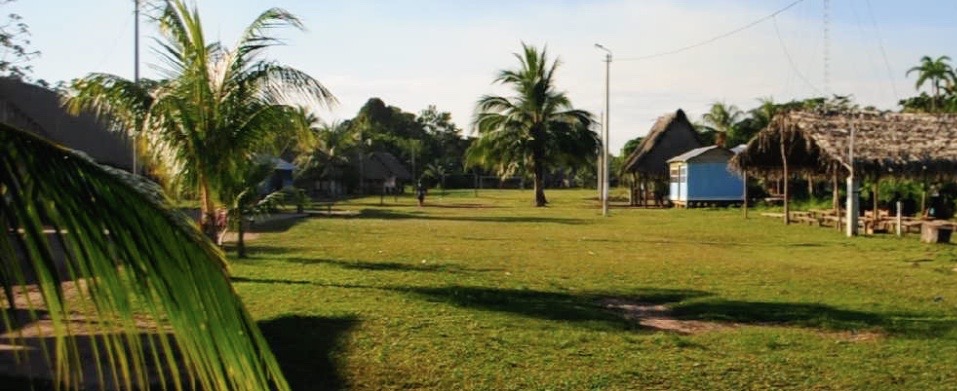
“The Shipibo are not warriors, like the Wampi or the Arawak. We are a peaceful people, just look at our history! We do art, weaving, and medicine. We don’t like to fight, we never have. We did not choose this fight; all we want to do is live in peace. But where will we live if they take away our forest? Donde vamos a vivir?”
Manuel’s hands patiently coax the knots out of his fishing line as he speaks, seated on a hammock in his kitchen. His house, like many Shipibo houses, is a modern adaption of a stilted living platform – a large wooden structure with a thick roof of woven palm fronds. At night, his family unrolls their sleeping mats and mosquito nets onto the platform. During the day, they tuck their belongings into the roof and the platform is transformed into a living area.
In Santa Clara de Uchunya, walls and doors are more decorative than functional. For the Shipibo, stealing is the greatest sin. To be a good person is to be generous and share any wealth you amass. Western concepts of private property, and cultural tendencies like hording and greed, are alien. This is likely part of why the encroachment of the foreign-owned oil palm plantation Plantaciones de Pucallpa onto ancestral Shipibo territory was so difficult for many in the village to comprehend.
***
The conflict started in August 2010 when a US-financed oil palm corporation, run by Dennis Melka under the name United Oils Ltd, started buying up small landholdings in and around the ancestral territory of Santa Clara de Uchunya. Peruvian Law has long dictated that farmers who clear and work ‘unoccupied’ land for 10 years in a peaceful, productive, and transparent manner, gain land title over the area they cultivate. However, defining what land is ‘unoccupied’ is difficult in a country where private property is favored over communal, where indigenous land-titling is not financed by the government and has not been granted for over 15 years, and where ancestral territory has no proper legal definition.
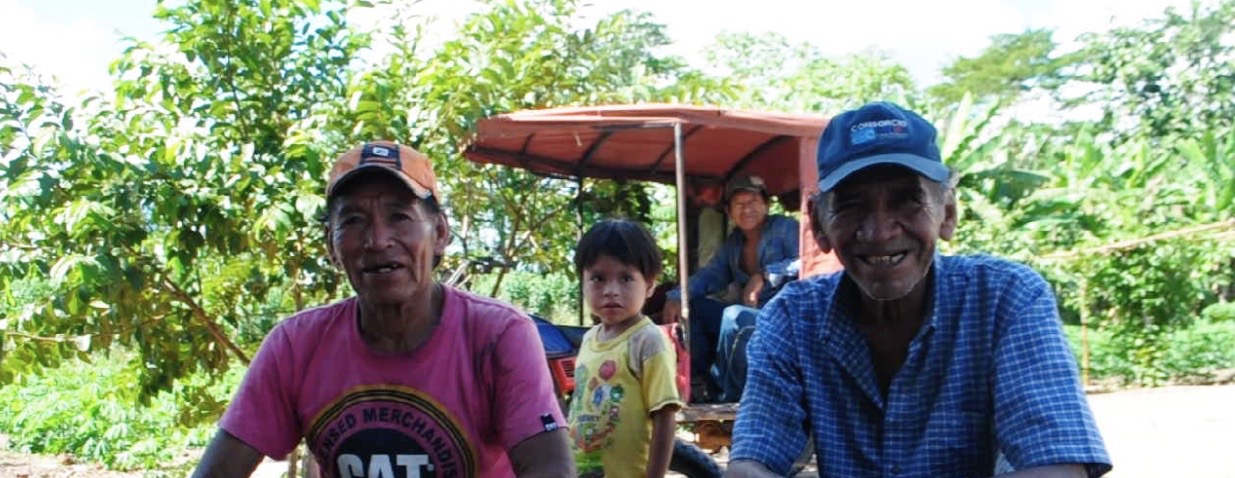
In total the plantation purchased 232 properties between 2010 and 2015, although it has since been revealed that many of these documents were falsified by the regional Department of Agriculture. In 2015, analysis of LANDSAT data by the international conservation agency Amazonian Conservation showed that 90% of the land deforested between 1990 and 2015 had been primary rainforest. Much of that land was also ancestral Shipibo territory, which served an important role in fishing, hunting, construction, swidden agriculture, and the collection of medicine.
I visit the plantation later that week. A thin barbed wire fence and a sign reading “Private property – do not enter” separate the forest from the plantation. As I step out of the forest into the oppressive noontime heat Manuel’s son, Vincente, points to a spot beyond the plantation where his chacra – swidden farm – used to be.
“I had plantain, cocoa, chonta growing there before the plantation cut off my access. Maybe they just cut it all down, who knows? The government just gave our land away, without consulting us, and now look at our home.”
I follow Vicente’s hand. The plantation stretches out in front of me, small palm tree heads cropping out of the ground every nine meters. As a crop, palm oil is emblematic of the agricultural-industrial complex. Wherever palm oil is grown, it leaves neat lines and rows upon a chaotic backdrop of green – the insidious footprint of capitalism on the rainforest. As a commodity, palm oil invisibly permeates most of our lives in the West. More often than we realize, it is present in the fuel that powers our cars, the pastries and condiments we consume, the cosmetics we apply, and the feed that fuels our meat industry. Our movements, bodies, and desires are fueled by the rampant destruction of the rainforest.
We leave the plantation for the shelter of the forest and start our two-hour trek back to Santa Clara de Uchunya. Under the canopy the rainforest is everywhere – birds calling from the branches, monkeys chattering, insects swarming. Ancient trees burst from the canopy, clusters of camu camu palm rise out of marshy swamps, lianas droop off the chaos of branches. The forest is, as many in the community tell me, a backdrop, a main stage, a path, a market, a backyard, an inspiration and a source of spiritual sustenance all at once. This immense forest sustains the thousands of human communities that live among its abundance, not to mention the millions more that benefit less directly from its services.
Back in the village, Manuel takes me to a nearby house where his neighbor is hosting a Minga – a work party. Land in Santa Clara de Uchunya is communally owned and distributed according to each family’s needs. Families regularly host mingas when clearing and planting needs to be done, such as now for the planting of yucca tubers.
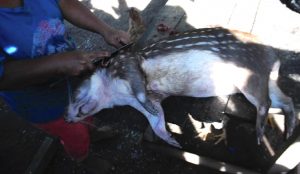
Under the shade of the hut the women are busy serving food and masato – a fermented drink made from chewed yucca – to the men who have returned. The men, who have already worked eight hours, are tired but jovial. They talk of the snake they scared while clearing land, and their predictions of the rainfall that everyone has been waiting for. Chickens run underfoot and children rock in the many surrounding hammocks. It is an idyllic scene, a brief moment of peace for the families of Santa Clara de Uchunya.
In between sips of masato, Katya recalls when she first became aware of the plantation. She remembers how, night and day, she and her neighbors heard chainsaws in the distance and saw swarms of birds rising from beyond their chacras. The men, she says, brought back fantastic stories of bulldozers plowing the forests, of animals found dead underfoot, of creeks that stopped flowing. In some ways, watching the sudden and grotesque destruction of their land, left community members temporarily paralyzed.
***
After villagers got over their initial shock at the plantation’s rapid encroachment onto their territory, they mobilized. Together with the local Environmental Prosecutors office, the Shipibo confronted workers in bulldozers who were clearing the forest. They were chased off with chainsaws, machetes and shotguns. What started as a series of small confrontations grew as the village banded together with outsiders –the regional indigenous federation FECONAU, and international environmental NGO’s – to lobby the national government and Roundtable for Sustainable Palm Oil (RSPO) to stop the encroachment.
It took the villagers of Santa Clara de Uchunya more than two years to get a response.
“We kept watching as they cleared the forest. From 2010 until 2013 they cleared huge amounts. The land became a desert; the burnt carcasses are all that remains of the forest. Then they started planting. Thousands of oil palms.”
Carlos, one of three young men who received media training from a local NGO to document the ongoing conflict, tells me this as we head out to fish one morning. It’s early, and the river is shrouded in heavy mist. The forest is still. It seems from here like the forest is sleeping. As if not to wake it up, we keep our voices low, almost to a whisper.
From Carlos’ perspective, the brunt of the conflict occurred between the end of 2015 and the summer of 2016, after the national government and the RSPO issued statements to the company asking them to halt operations. The company continued regardless, the government and RSPO undertook no enforcement measures, and the ire of plantation supporters was directed at the village.
Carlos points to a patch of river bank as we paddle by. “That is where the men landed who threatened us the first time. They came on a speedboat from the plantation up the river. Masked, and with shotguns”. The villagers’ response was immediate. All of the men gathered their own shotguns, usually used for hunting the prized sachavaca – tapir – from the forest, and fired shots into the air. This scared off the boat of men. After that, Carlos recalls, the village men stayed armed most of the time.
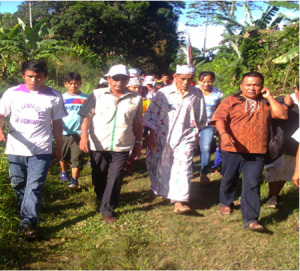
I personally witnessed the rest of the violence directed at the village. Soon after I arrived the plantation shut down road access to Santa Clara de Uchunya, and the leaders of the resistance received multiple death threats. The plantation owners financed a protest of oil palm smallholders from the nearby mestizo town of Nueva Requena. The protesters gathered outside the office of Pucallpa’s Mayor, where they declared the indigenous Shipibo leaders “persona non grata” in the region. Many of the leaders were forced to flee to Lima.
Leaving the village of Santa Clara de Uchnya became dangerous, as the men had to pass through neighboring Nueva Requena. Nevertheless, the three men who were receiving media training persisted, sometimes walking six miles out of their way to reach the next nearest town of Shambo. From there they could take a rickety taxi two hours over dirt roads to Pucallpa.
Carlos’ voice is proud as he relates his story. He is a fisherman, he says, like most Shipibo. He wants to fish in the bay where his grandfather fished, and for his children to be able to fish in these waters too. He is worried about the untreated sewage from the workers’ camps that now flows into the bay, the plantation’s overfishing to feed its workers, and the effects of continual harassment on the community’s mental health. “But what can I do? This is our land” he says, “this forest is our marketplace, our pharmacy, our school, our mother. It is our home, there is nowhere else to go; seguimos luchando”.
Seguimos luchando – we will continue to fight. I have heard this tired phrase too many times to count since I arrived in Santa Clara de Uchunya. It rolls easily off the tongues of the men and women who, for the past 5 years, with little external help, have done exactly that. They have fought what they see as a goliath, in order to keep their land, their home, their identities, and their peace.
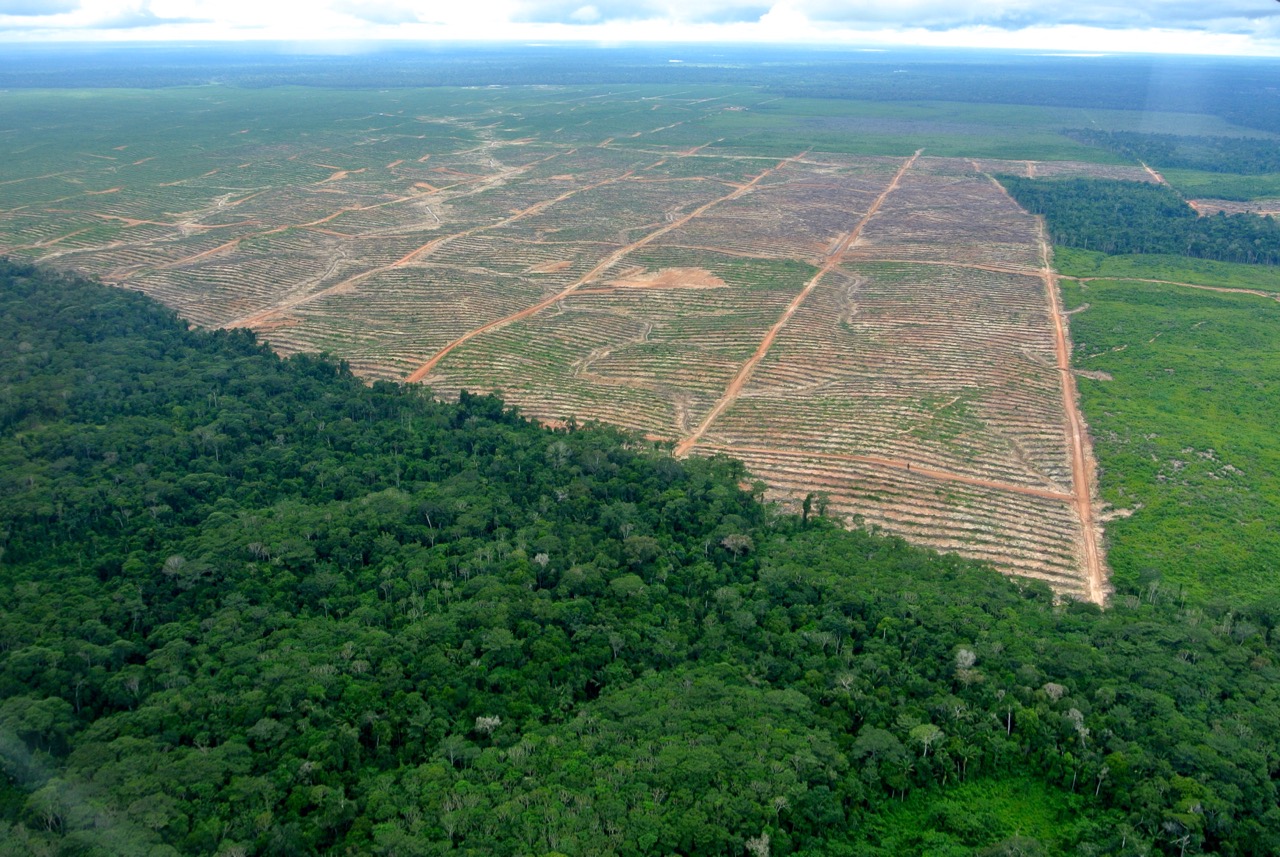
Carlos has caught two large fish, enough to feed his family for the day. Tomorrow he’ll be back, taking only what he needs from the endless bounty that still surrounds the village, sharing what he has with those around him, nurturing a communal way of life shared by many indigenous groups in the Amazon.
As we turn to paddle back we are caught, for an instant, in a mystical moment. The sun burns through the mist, bringing to life the roar of the millions of birds, insects, and beasts that inhabit the surrounding forest. The noise is deafening and takes my breath away. The sheer beauty and power of the largest forest in the world waking up and stretching its millions of arms skywards in a colorful, ethereal dance of sound, light and motion is overpowering. The moment reverberates through my soul.
Carlos stops paddling and watches the birds rise up above the tree line as the sun peeks over the horizon. Out on the oxbow lake of Santa Clara de Uchunya, the image of him standing in the prow of his canoe will stay burned in my memory forever. He looks amused, and sad, at the same time.
“My home. It’s beautiful, isn’t it?”
He looks once more at the bay, and then turns around and leans into his paddle. We head back to shore.